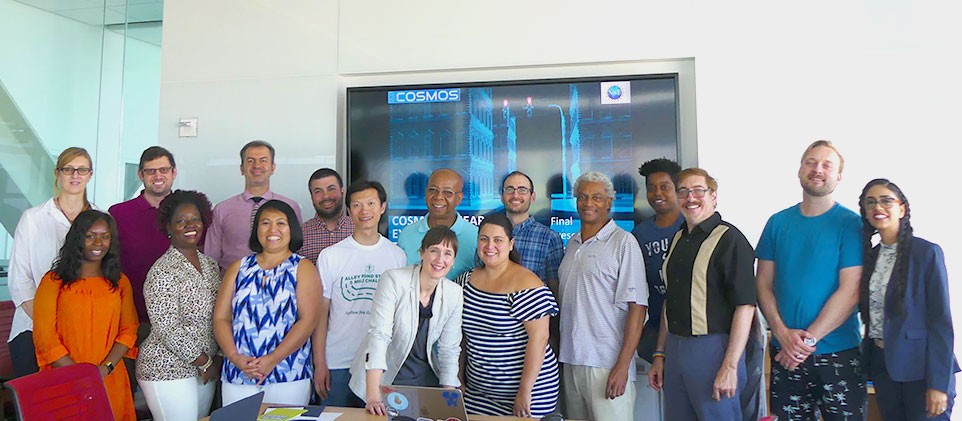Columbia and NYU COSMOS Researchers Work with 10 Teachers on Designing Lab Experiments

Ten New York City math, science, robotics, and art and technology teachers spent the summer learning how to master the most advanced techniques in wireless technology with help from researchers at Columbia University, Columbia’s Data Science Institute, and NYU. The middle and high school teachers teamed up with researchers on both campuses to design web-based lab experiments that illustrate the theory and practice of wireless networking. The teachers, four of whom are from Harlem schools, will begin using the lab experiments in their classrooms this fall, giving students hands-on experience with the next wave of mobile technology.
“We want to share the cutting-edge technologies we are developing with teachers, school students, and the broader community in Harlem and throughout NYC,” says Zoran Kostić, associate professor of electrical engineering and member of the Data Science Institute, who led the Columbia effort along with Columbia Engineering Outreach. “When we received the grant, one of our top priorities was to craft COSMOS as an educational platform to improve K-12 STEM education in city schools.” The selected teachers spent the first part of their summer learning about the program. Then the teachers were divided between Columbia and NYU labs. Kostić described the summer program for the teachers as “successfully intense,” with the faculty, postdocs, students, and teachers working together to develop 35 lab experiments.
At the end of the summer, the teachers were given COSMOS educational toolkits composed of PCs, wireless devices, sensors, and software-defined radios. Their students will use the toolkits in their experiments, which eventually will be connected through the web to the COSMOS testbed, allowing them to follow the experiments done by the researchers in real time. As the teachers begin implementing the lab experiments, Columbia and NYU researchers will visit their classrooms and continue to mentor them. The teachers will also present this innovative curriculum at upcoming conferences.
Harry Title, an art and technology teacher, designed a lab project that will teach students about sound waves and sound modulation through the use of GarageBand, the software program for creating music or podcasts. “All kids listen to music on their cell phones,” says Title, “so connecting how sound waves travel to their use of GarageBand will help me get the attention of my students.”
Melissa Sanchez, a math teacher and colleague of Title’s at the Urban Assembly Academy for Future Leaders, learned that the COSMOS network will tap unused radio spectrum bands and integrate optical fibers underground while installing radio antennas on city rooftops and light poles. The high-bandwidth network, she further learned, will transmit data at rates above one gigabit per second, improving performance tenfold over current wireless networks. Sanchez was impressed by the technology, but the question for her was how to translate these innovations into algebra experiments for her students.
Working with her Columbia mentor, she designed a lab in which students can calculate the unit price for bandwidth, which helps her teach proportional relationships—one of her themes in algebra. As part of the lab she designed, her students have to collect data and compare internet providers, as well as analyze variables such as the price and upload speeds of the different companies. “The summer program was definitely intense,” she adds, “but in the end the experiments we designed will make abstract concepts more concrete for my students. And that will help them better understand and enjoy their math classes.”
The Research Experience for Teachers activity took place with the recently funded $22.5 million National Science Foundation (NSF) project called Cloud Enhanced Open Software Defined Mobile Wireless Testbed for City-Scale Deployment, or COSMOS. COSMOS is an advanced wireless testbed covering a square mile, mostly in Harlem, which is being developed and deployed in West Harlem by Rutgers, Columbia, and NYU. More details about the COSMOS project are available via the COSMOS project website.
A version of this article originally appeared on the Columbia University Data Science Institute website.
We would like to recognize the following individuals and organizations for their leadership in this effort: Columbia Engineering Outreach, led by Emily Ford; NYU Center of K-12 Education, led by Ben Esner and Dr. Sheila Borges; the Columbia Office of Government and Community Affairs; Silicon Harlem; Zoran Kostić, associate professor of electrical engineering and member of the Data Science Institute; Thanasis Korakis, NYU associate professor of electrical and computer engineering; Dr. Jonathan Ostrometzky, Dr. Hazel Yüksel, and Tony Zheng, Columbia University electrical engineering professors; and Data Science Institute members Harish Krishnaswamy and Gil Zussman.
This article was originally published in the Fall/Winter 2018 issue of The Columbia Newsletter, which is available for download.